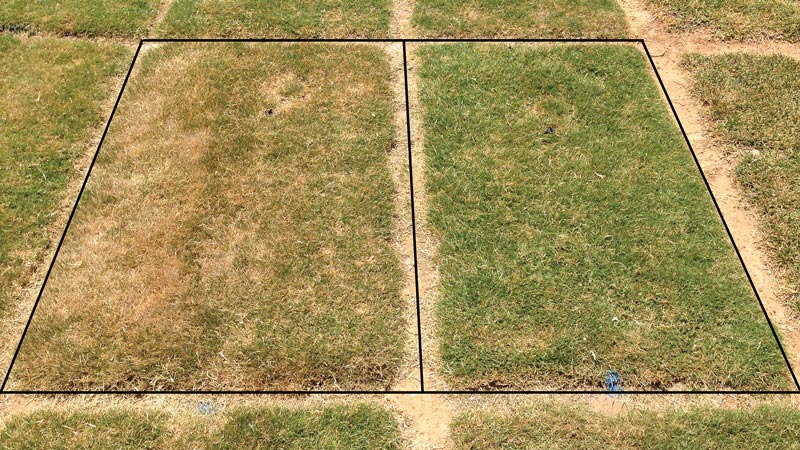
Tifway (left) and TifTuf (right) bermudagrass during the 2016 drought trial. TifTuf was the best performer throughout the trial. Photo by David Jespersen
Drought is an important environmental stress that causes widespread damage to turfgrass species. Plants under drought stress will have reduced growth, wilting, loss of color, leaf firing and eventually plant death.
The demand for more sustainable turfgrasses makes the development of drought-tolerant turfgrasses an essential goal for many turf scientists. The ability of a plant to survive water-limited conditions depends on the complex interaction of many factors, including how quickly plants uptake and transpire water, and the accumulation of protective compounds.
The objectives of this study were to compare bermudagrass (Cynodon species) and seashore paspalum (Paspalum vaginatum Swartz) cultivars exposed to drought conditions and determine their relative performance, as well as the underlying differences responsible for variations in drought tolerance.
Methods
Six cultivars — three seashore paspalums (SeaStar, Sea Isle 1 and an experimental cultivar, UGA 1743) and three bermudagrass cultivars (Celebration, TifTuf and Tifway) — were established in field plots equipped with an automatic rainout shelter at the University of Georgia’s Griffin campus. The rainout shelter has a motorized cover that moves over plots to prevent rain from affecting soil moisture levels.
After establishment, plots were exposed to drought stress in the summers of 2016 and 2017. During these drought periods, plots received no irrigation, and the rainout shelter prevented natural precipitation from reaching plots.
Each drought period lasted for 28 days, during which weekly measurements were taken to assess drought performance and physiological differences among cultivars. Measurements included overall visual turf quality and assessment of green canopy coverage by digital image analysis and NDVI (normalized difference vegetation index) measurements. Additional measurements included leaf water content, membrane stability to estimate cellular damages, respiration rates based on CO2 exchange, and osmotic adjustment, which measures the accumulation of solutes within cells in response to drought.
Results
A range of drought performance was seen among the bermudagrass and seashore paspalum cultivars when water was withheld during the trials.
TifTuf bermudagrass was the top performer in both years of the trial because it was better able to maintain turf quality and canopy coverage based on NDVI (Figure 1A). In addition, TifTuf had greater leaf water content as drought progressed, indicating less cellular dehydration (Figure 1B). Although TifTuf was not always significantly better than all other grasses on every measurement, it was consistently in the top statistical group across both years.
In contrast, SeaStar seashore paspalum had the poorest drought performance, experiencing the greatest decline in turf quality and drought-related damage. Regardless of species, the other cultivars generally had similar drought performance, with water content and membrane stability being good indicators of drought performance.
In comparison to paspalums, bermudagrasses generally were better able to regulate energy metabolism and used osmotic adjustment to greater degrees, potentially indicating species-specific drought responses. Osmotic adjustment occurs when solutes accumulate within the cells, which helps the plant keep water in the cells and protect against drought. TifTuf consistently used osmotic adjustment mechanisms in response to drought.
Conclusions
Variations in drought tolerance were found among a collection of bermudagrass and seashore paspalum cultivars. TifTuf bermudagrass was the top performer across both years, and it is likely that the exceptional levels of drought tolerance seen in TifTuf are the result of several stress tolerance mechanisms working together. However, osmotic adjustment is likely to be an essential component of the observed drought tolerance. Solutes that accumulate during drought as a part of osmotic adjustment, including sugars and amino acids, protect the cell by helping maintain cellular water content.
Although the most tolerant grass was a bermudagrass and the least tolerant was a seashore paspalum cultivar, the top-performing seashore paspalum cultivar, UGA 1743, had drought tolerance levels on par with some bermudagrasses, demonstrating that a range of drought tolerance exists in both species.
Mechanisms responsible for drought tolerance will continue to be explored as more improved cultivars with high levels of stress tolerance are developed.
Funding
This research was supported by funding from the USDA National Institute of Food and Agriculture Specialty Crop Research Initiative and Georgia Agricultural Experiment Stations.
Acknowledgments
This research was previously published as “Drought performance and physiological responses of bermudagrass and seashore paspalum” by David Jespersen, Monique Leclerc, Gengsheng Zhang and Paul Raymer in Crop Science 59:778-786 (2019). doi:10.2135/cropsci2018.07.0434
David Jespersen is an assistant professor, Monique Leclerc is Regents professor, and Paul Raymer is a professor in the Department of Crop and Soil Sciences, College of Agriculture and Environmental Sciences, University of Georgia, Griffin, Ga.